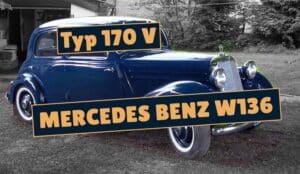The exciting long history of classic cars from the powerhouse that is Mercedes today wouldn’t be complete without a solid mention of The Mercedes-Benz Typ 8/38 PS / Typ Stuttgart 200 (W02) or Mercedes-Benz W02. Following the Daimler/Benz merger in 1926, this bad boy was the first car to be developed. Talk about starting a new franchise with a bang! The Mercedes-Benz W02 was a midsize six-cylinder two-liter-engined automobile premiered by Daimler-Benz at the Berlin Motor Show in October 1926.
This car can be said to have been developed with a high sense of urgency by the manufacturer’s Technical Director, Ferdinand Porsche, in line with the smaller Mercedes-Benz W 01 (which was never developed as it didn’t get past the prototype stage) and the larger three-liter-engined Mercedes-Benz W03 following the creation of Daimler-Benz, officially in July 1926.
The new company’s model in 1926 was not burdened by an excess of technical complexity but was furnished with quality. The development of some serious teething problems noticed in the early cars was the main focus of a disagreement between Daimler-Benz Chairman Wilhelm Kissel and the Technical Director responsible for the new models. In the light of this fallout, Porsche’s contract was not renewed beyond 1928.
Like many cars produced in that period, the Mercedes-Benz W02 followed a particular German naming system, which was very popular then. At first, it was called the Mercedes-Benz 8/38 PS. The “8” defined the car’s tax horsepower, while the “38” defined the manufacturer’s claims regarding the car’s exact power output as defined in Horsepower.
This model system of naming, which had been defined by statute in 1906, was based on the engine’s dimensions. In contrast to other systems in Europe, the German tax horsepower calculation took into account both the cylinder bore and the cylinder stroke. Therefore, there was a direct linear relationship between engine size and tax horsepower.
Mercedes-Benz W02 – Overview
The Mercedes-Benz W02 was sold in chassis form to those customers who wanted to obtain the bodywork from a private builder. Meanwhile, you could still get standard bodies from the manufacturer, which kicked off with Torpedo-bodied Tourenwagen and included a 2 or 4-door “Limousine” (sedan/saloon) body. A choice from two different Mercedes-Benz cabriolet bodies was also included. A maximum output of 38 PS (28 kW) at 3,400 rpm, which translated into a max top speed of 75 km/h, was the result of a side-valve six-cylinder 1,988 cc engine.
Power transmission was made possible through a three-speed manual transmission to the rear wheels, which were fixed to a rigid axle suspended from semi-elliptic leaf springs, and the brake system was applied to all four wheels using mechanically controlled rod linkages.
Mercedes-Benz W02 – Upgrade
After the re-launch, the car, which was now rebranded as the Mercedes-Benz Typ Stuttgart 200, retained its 1,988 CC side-valve engine as well as maximum output, which remained unchanged at 38 PS (28 kW; 37 hp). However, this level of output became achievable at a marginally reduced engine speed of only 3,200 rpm. In addition, customers could now request a four-speed manual transmission, although the three-speed transmission was still available. This made a lot of customers super excited.
Although a fine engine for its time, the Mercedes-Benz W02 was rapidly tweaked to offer more power and soon evolved into next-generations models. However, the engine’s basic architecture remained the same, placing the W02 among some of the best engines produced by Mercedes. The manufacturers were now able to increase the listed top speed to 80 km/h (50 mph), which was a combined effect of the changes made to the engine and transmission systems.
Mercedes-Benz W02 – Production
The Mercedes-Benz was one of the flagship models from 1927 to 1931 and it commanded massive sales from the 4,788 cars produced in 1927 which represented 61% of the manufacturer’s output. Further sales in subsequent years include;
- 1928: 3,938 cars / 63%,
- 1929: 5,640 cars / 56%,
- 1930: 4,453 cars / 69%,
- 1931: 2,320 cars / 70%,
- 1932: 885 cars / 15%
Production came to an end in 1933. At this time, over 16000 cars had been sold. A befitting statistic to end a classic tale as it will always be remembered as the model that launched Mercedes.

![You are currently viewing Mercedes-Benz W02 [Mercedes-Benz Typ 8/38 PS] – (1927 – 1931)](https://classicsdude.com/wp-content/uploads/2021/05/Mercedes-W02-website.jpg)

![Read more about the article Mercedes-Benz S-Series [S/ SS/ SSK/ SSKL Models] (1927 – 1933)](https://classicsdude.com/wp-content/uploads/2021/05/series-S-website-300x174.jpg)
